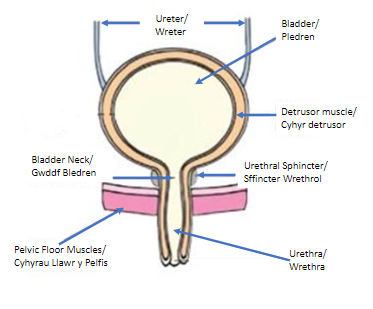Men's Health

Good pelvic floor muscle function is important for bladder and bowel control, and for sexual function. The pelvic floor muscles help to prevent leakage of urine, wind or faeces. They also need to be able to relax fully to allow the bladder and bowel to fully empty. Your pelvic floor muscles are also important for helping to maintain an erection.
Strengthening your pelvic floor muscles if they are weak may help to resolve your symptoms.
This animation shows the location of your pelvic floor muscles - Anatomy of the male pelvic floor
This video explains how to do pelvic floor muscle exercises (also known as Kegels) Male pelvic floor exercises
Pelvic floor exercises are also explained in these leaflets:
- Pelvic Floor Exercises for Men
- Pelvic floor muscle exercises (for men) - This booklet is written by the POGP (Pelvic, Obstetric and Gynaecological Physiotherapy), a UK based Physiotherapy Professional Network affiliated to the Chartered Society of Physiotherapy
Using an app such as Squeezy for Men can help, as you can set reminders at times that suit your daily routine.
The following videos have been produced by the Urology Specialist Nurses and Pelvic Health Physiotherapists. They address common questions that men undergoing prostatectomy often ask about how to manage and reduce incontinence symptoms:
- Physio and Urology advice including pelvic anatomy and pelvic floor exercises
- Pad Advice
- Fluid Advice
- Catheter Care
Pelvic floor exercises are also explained in these leaflets:
- Pelvic Floor Exercises for Men
- Pelvic floor muscle exercises (for men) - This booklet is written by the POGP (Pelvic, Obstetric and Gynaecological Physiotherapy), a UK based Physiotherapy Professional Network affiliated to the Chartered Society of Physiotherapy
Healthy bladder habits are important to help reduce urge incontinence:
Useful Websites and Apps
Information Leaflets

The kidneys filter our blood to remove excess water, waste, and produce urine, which travels along the ureters to the bladder. The bladder stores the urine and then empties it out.
We tend to get the initial desire to pass urine when it is holding approximately 150mls, but we often ignore these first signs. Generally, people visit the toilet to pass urine when it is convenient, and the bladder is holding approximately 400mls urine. This volume tends to be larger for the first void (wee) of the day.
A healthy bladder will need emptying up to 6-8 times per day, and not more than once during the night.
A healthy bladder should give us plenty of warning when it is getting full, be free of infections, and empty fully without pain or blood in our urine.
Aim to drink between 1.5 – 2 litres (6-8 mugs) daily.
- Stress Incontinence – leakage of urine on exertion such as coughing, sneezing and during exercise
- Urge Incontinence – leakage of urine occurring when there is not enough time to reach the toilet
If you are experiencing stress incontinence and/or urge incontinence, strengthening your pelvic floor muscles may help to resolve your symptoms
This animation shows the location of your pelvic floor muscles - Anatomy of the male pelvic floor
This video explains how to do pelvic floor muscle exercises (also known as Kegels) Male pelvic floor exercises
Pelvic floor exercises are also explained in these leaflets:
- Pelvic Floor Exercises for Men
- Pelvic floor muscle exercises (for men) - This booklet is written by the POGP (Pelvic, Obstetric and Gynaecological Physiotherapy), a UK based Physiotherapy Professional Network affiliated to the Chartered Society of Physiotherapy
Constipation refers to infrequency or difficulty opening your bowels, where stools may be hard, lumpy or painful to pass.
Further information and tips for avoiding constipation can be found below:
- Constipation (NHS)
- Constipation (Guts UK)
- Fibre Fact Sheet (BDA)
- Tips to Encourage Healthy Bowel Habits
It is important that you regularly check your stools to rule out more serious conditions that can affect bowel function.
Key signs and symptoms to look out for can be found on the bowel cancer UK website-Bowel Cancer Symptoms
It is important to avoid straining if you are having difficulty opening your bowels.
Repetitive straining can weaken your pelvic floor and increase your risk of developing complications such as haemorrhoids.
Adapting the position you use to sit on the toilet can help ‘straighten out’ the back passage, which makes it easier to pass stools. This sheet gives information about the best position to use- Correct Position for Emptying Bowels
- The following videos may also be useful:
- How To Open Your Bowels Without Straining (Michelle Kenway)
- 'I Love You' Abdominal Massage (ECO Physiotherapy)
It’s important to ensure you relax your pelvic floor muscles when emptying your bowels, and difficulty relaxing the pelvic floor can contribute to problems with emptying.
The video below guide you through techniques to encourage relaxion of the pelvic floor whilst on the toilet:
Guided Visualization for Elimination (Constipation, Urinary Hesitancy, Incomplete Bladder Emptying)
Pelvic floor dysfunction can contribute to difficulties emptying the bladder and/or bowels. This can be due to either a weak or a tense pelvic floor. Assessment by a pelvic health physiotherapist will be able to guide you on whether your pelvic floor muscle needs strengthening or releasing if the above tips haven’t worked.
Healthy Bowels should empty anything between 3 times per day and 3 times per week.
A stool (poo) should be easily passed without straining, pain, or blood.
It is important to avoid constipation and straining to empty your bowels as this can contribute to pelvic floor dysfunction.

Adjusting your position on the toilet

Drinking enough fluids

Eating plenty of fibre
All of the above can help, along with taking any medication prescribed for you. If you have difficulty emptying your bowels the section below has more information on this.
Bowel control problems can affect people in different ways:
-
Sudden urges to poo that you can’t control
-
Accidental bowel leakage
-
Being unable to hold on to wind
The information below may be helpful:
Weak pelvic floor muscles can contribute to bowel control problems. They can be strengthened by doing regular pelvic floor muscle exercises. This animation shows the location of your pelvic floor muscles - Anatomy of the Male Pelvic Floor
This video explains how to do pelvic floor muscle exercises (also known as Kegels) Male Pelvic Floor Exercises
Pelvic floor exercises are also explained in these leaflets:
-
Pelvic Floor Muscle Exercises (for men) - This booklet is written by the POGP (Pelvic, Obstetric and Gynaecological Physiotherapy), a UK based Physiotherapy Professional Network affiliated to the Chartered Society of Physiotherapy
- Using an app such as Squeezy for Men can help, as you can set reminders at times that suit your daily routine
Healthy bowel habits are important as straining to empty your bowels can make symptoms worse:
For more support you can contact the Bladder and Bowel Community
- Chronic prostatitis
- Prostate and urethra problems - Chronic prostatitis
- Contributing factors to CPPS
See below for some useful information that you may find helpful if you have tension in your pelvic floor muscles:
- Pelvic Pain Foundation of Australia
- Top 3 Pelvic Floor Stretches for Women and Men
- Easy stretches to Relax the Pelvis
- Relaxing Your pelvic floor with Bill Taylor
- 15 Min Bedtime Pelvic pain Release for Men
All exercises and stretches that you do should be completely comfortable, so stop if you experience any discomfort.
The information below may be helpful if you have a persistent pain condition:
Maintaining a healthy weight can help to alleviate bladder and bowel symptoms - Weight Management
If you would like further help with this you can self refer to the Adult weight management service : Request for Support for losing weight (office.com)
Stopping Smoking can help to alleviate bladder leakage by reducing coughing associated with smoking - Help Me Quit
Aneurin Bevan University Health Board and partners have developed the ‘melo’ website to look after the mental wellbeing of its residents. Melo can help you to develop new skills that will support you when life is difficult.
Exercise - Physical activity guidelines for adults aged 19 to 64 - NHS (www.nhs.uk)
Fitness Studio exercise videos - NHS (www.nhs.uk)
Physical activity for adults and older adults (publishing.service.gov.uk)
If you have tried the exercises and advice but still feel you would like to see a Pelvic Health Physiotherapist regarding any ongoing bothersome symptoms, you can request a referral from your:
- Consultant
- Urology Nurse Specialist
- Bladder and Bowel Nurse Specialist
- GP